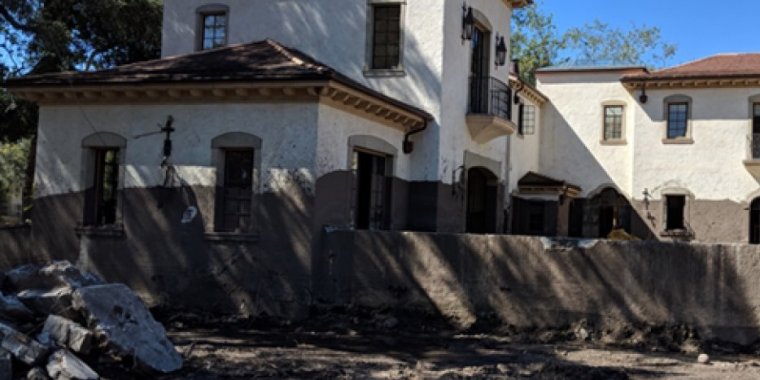| News / Science News |
Physics of disaster: How mudslides move
In early December 2017, the Thomas Fire ravaged nearly 300,000 acres of Southern California. The intense heat of the flames not only killed trees and vegetation on the hillsides above Montecito, but vaporized their roots as well.

The 2018 mudflows, which followed a fire and then heavy rain, were powerful and destructive. Photo: Douglas Jerolmack
A month later, in the pre-dawn hours of January 9, 2018, a strong storm pelted the barren slopes with more than half an inch of rain in five minutes.
The rootless soil transformed into a powerful slurry, churning down a creek-carved canyon and picking up boulders in the rush before fanning out at the bottom and barreling into homes. Twenty-three people died in the disaster.
Could this tragedy have been avoided? What is the tipping point at which a solid slope begins to ooze like a liquid? New findings from a team led by Douglas Jerolmack and Paulo Arratia of the University of Pennsylvania in collaboration with researchers at the University of California, Santa Barbara apply cutting-edge physics to answer these questions.
The researchers performed laboratory experiments that determined how the failure and flow behavior of samples from the Montecito mudslides were related to material properties of the soil.
"We weren’t there to see it happen," says Jerolmack, "but our idea was, 'Could we learn something about the process of how a solid hillside loses its rigidity by measuring how mixtures of water and soil flow when they’re at different concentrations?'"
The scientists looked at samples from the devastated remains of homes, where mud flows from the hillside were strong enough to push massive boulders down creek beds all the way up to — and sometimes through — houses.
Taking the samples back to the lab, the researchers' goal was to model how the composition of the mud and the stresses it is subjected to influence when it begins to flow, overcoming the forces that lend substances rigidity, what scientists call a "jammed state."
The group's work leaned on an understanding of cutting-edge physics related to the forces at work. These include friction, as particles rub against one another; lubrication, if a thin film of water helps particles slide past one another; or cohesion, if sticky particles like clay bind together.
Climate change effects, such as wildfire frequency and intensity, are increasing in many regions, as is the intensity of precipitation events. The risk of catastrophic mudslides isn't disappearing.
The new findings on predicting yield stress and the jammed state can help inform modeling to simulate debris flows, the researchers say. "If it rains this hard and I have this kind of material, how fast is it going to flow and how far," Jerolmack says. (U.S. National Science Foundation)
YOU MAY ALSO LIKE





